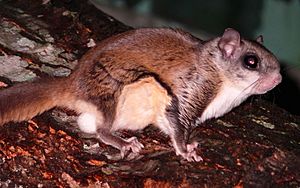Carolinian forest facts for kids
The Carolinian forest is a special type of forest found in eastern North America. It's mostly made up of deciduous trees, which are trees that lose their leaves every autumn.
The name "Carolinian" is often used in Canada. It refers to the forests that stretch from the Carolinas in the United States all the way up to southern Ontario, Canada. These forests in both countries share many similar trees and animals. In the U.S., this forest is often called the "Eastern deciduous forest."
Contents
Where is the Carolinian Forest?
This forest zone covers a large part of the eastern United States. You can find it in the Carolinas, the Virginias, Kentucky, Tennessee, Maryland, Delaware, Pennsylvania, and parts of Ohio, New York, Connecticut, and Rhode Island. It also reaches into small areas of Michigan and Indiana.
The Carolinian forest also extends into Southern Ontario, Canada. This Canadian part is in a very fertile area called the Mixedwood Plains.
What Lives Here?
Many different trees grow in this forest. Some common ones include various types of ash, birch, chestnut, hickory, oak, and walnut trees. The tallest tree here is often the tulip tree. You can also find fruit trees like the pawpaw.
The forest is home to many animals too. You might see raccoons, possums, and squirrels. This includes the special southern flying squirrel. Birds like nuthatches and chickadees also live here.
Carolinian Canada: A Special Place
The Carolinian forest in Canada is located at the southern tip of Ontario. It's nestled between Lake Erie, Lake Huron, and Lake Ontario. This area is incredibly rich in biodiversity, meaning it has a huge variety of plants and animals. More than 500 species found here are considered rare.
Why is the Climate Unique?
The reason for so much life here is its special climate. The Carolinian forest in Ontario has the warmest average temperatures each year. It also has the longest time without frost and the mildest winters in all of Ontario. This unique weather is largely thanks to the nearby Great Lakes. The lakes help keep the surrounding land warm.
Challenges for the Forest
The land in this region is very fertile, which means it's good for growing things. Because of this, the area has become very developed and populated. There are many farms, factories, businesses, and cities here. Today, the Carolinian Zone has major cities and is home to one-quarter of Canada's population. This is a lot, considering it's only 0.25% of Canada's total land.
This development has caused a lot of habitat loss. Forests have been cut down, and wetlands have been drained. The remaining forest areas are often scattered and disconnected. It's estimated that forest cover has dropped from 80% to just 11.3%. Wetlands have also shrunk from 28.3% to 5.1%.
Native Carolinian species also face threats from invasive species. These are plants or animals that are not from here and can harm the local ecosystem. Examples include garlic mustard and buckthorn. White-tailed deer also cause problems by overgrazing, which means they eat too many plants.
All these issues make the Carolinian zone the most threatened region in Ontario. Over 125 species of plants and animals are listed as vulnerable, threatened, or endangered. This is more than one-third of all such species in Canada.
Protecting the Forest
To help save this unique forest, some natural areas are now protected. For example, there are many protected places like Point Pelee National Park and 21 provincial parks. Some of the best-preserved areas are in Windsor's Ojibway Park and Rondeau Provincial Park. The Niagara Glen Nature Reserve is another important protected spot.
Organizations like the Carolinian Canada Coalition are also working to restore the region. It's important to know that Carolinian forests are complex. They cannot be easily recreated in small gardens. The best way to save this special habitat is to protect large areas of land from development and farming.
Efforts have also been made to manage the white-tailed deer population. Their numbers were reduced to help the forest recover from overgrazing. While this helps, it takes a long time for the forest to fully heal. Keeping deer numbers low and protecting young trees are important steps to help the Carolinian forest survive.
Examples of Species
Animals (Fauna)
- White-tailed deer
- American black bear
- Virginia opossum
- American badger
- Gray fox
- Bobcat
- Southern flying squirrel
- Wild turkey
- Ruffed grouse
- Hooded warbler
- Prothonotary warbler
- Canada Warbler
- Carolina wren
- Yellow-breasted chat
- Northern cardinal
- Red bellied woodpecker
- Red-tailed hawk
- Barn owl
- Eastern box turtle
- Spotted turtle
- Eastern hognose snake
- Eastern spiny softshell turtle
- Eastern fox snake
- Red salamander
- Karner blue butterfly
Plants (Flora)
- Eastern prickly pear cactus
- Tulip tree
- Sassafras
- Miami mist
- Kentucky Coffee Tree
- Flowering Dogwood
- Black Walnut
- American Chestnut
- Sycamore
- Red Mulberry
- Black Gum
- Red Maple
- Eastern White Pine
- Eastern Hemlock
Rivers and Creeks
- Ausable River
- Catfish Creek
- Credit River
- Grand River
- Kettle Creek
- Sydenham River
- Thames River
- Twenty Mile Creek
- Welland River
- Nith River
Other Important Areas
- Oak Ridges Moraine
- Rouge Park
- Barker's Bush
- Awenda Provincial Park
- Point Pelee National Park



